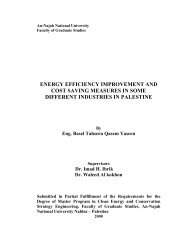THE GENUS PYTHIUM - An-Najah National University
THE GENUS PYTHIUM - An-Najah National University
THE GENUS PYTHIUM - An-Najah National University
Create successful ePaper yourself
Turn your PDF publications into a flip-book with our unique Google optimized e-Paper software.
B. Isolation of Pythium spp from infected plant parts:<br />
Pythium spp were isolated from infected plant tissue by plating on the VP3<br />
medium plates or on plates of 2% water agar containing 5 mg( L pimarinin.<br />
Excised plant material was first washed under running tap water for about 2<br />
hours, surface-sterilised in 0.5% sodium hypchlorite for 3 miniutes, rinsed in<br />
sterile distilled water, blotted dry on sterile filter paper, and then plated on the<br />
agar plates. The plates were then incubated at 22-250 C for 24-48 hours and<br />
examined for the presence of Pythium colonies.<br />
MAINTENANCE OF STOCK CULTURES<br />
Stock cultures of representative isolates of Pythium species studied were<br />
maintained either in water culture in 100mi conical flasks (Dick, 1965), or on<br />
CMA slants (Robertson, 1980; Plaats-Niterink., 1981) in 100mi universal bottles.<br />
All the stock cultures were kept at 100e.<br />
IDENTIFICA TION OF <strong>PYTHIUM</strong> SPECIES<br />
Transfer of colonies from rough cultures: Small excisions from growing margin<br />
of Pythium colonies. on the isolation plates or on rinsed baits were cut off and<br />
either transferred directly to water culture with 1-2 autoclaved corn kernels per<br />
dish, or to corn meal agar (CMA) or 2% water agar plates, and then transferred<br />
into water culture after they had been incubated for 24-48h at 220 C.<br />
Representative isolates of the isolated species (3 of each) are maintained at the<br />
Fungal Culture Collection of <strong>An</strong>-<strong>Najah</strong> <strong>University</strong> (Ali-Shtayeh, 1986b).<br />
Induction of sporangial and zoospore formation: For production of sporangia<br />
and zoospores, dishes were half-filled with sterile distilled water (OW) or with<br />
an autoclaved mixture of one part filtered pond water and two parts distilled<br />
water (DDW). Two grass blades (Emerson, 1958), boiled for IS minutes, were<br />
then placed on or near the hyphal tips. Coloized grass blades were then<br />
transferred to new dishes half-filled with water (OW or OOW as appropriate),<br />
incubated for 24-48 h at 10-22° C, rinsed daily with water from the same source,<br />
and examined periodically for 2-7 days for zoosporangia . If zoospores were not<br />
produced at these temperatures, cultures were put in a refrigerator at 2-50 C for<br />
1-2 h before they were examined for zoospore production. Changing the water<br />
and chilling the cultures may enhance both the production of sporangia and the<br />
discharge of zoospores (Ali, 1982).<br />
Induction of sexual structures formation: For production of sexual structures<br />
similar blocks of agar containing hyphal tips were flooded with OW. Two boiled<br />
corn kernels were placed adjacant to the hyphal tips and cultures were then<br />
incubated at 22 0 C for 7-14 days before they were examined. When oogonia were<br />
not produced in water culture, isolates were grown on Schmitthenner's medium<br />
(Schmitthenner, 1962) or on CMA supplemented with wheat germ oil (500<br />
mg( L) to provide sterols needed for sexual reproduction (Hendrix & Papa,<br />
1974). Schmitthenner's medium and CMA supplemented with wheat germ oil<br />
were found to be satisfactory for oogonial production and microscopic<br />
examination was easy because of the clear substrate.<br />
6





